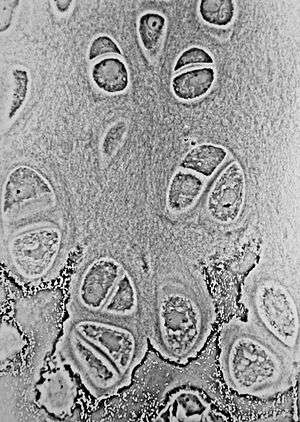Chondrocyte
| Chondrocyte | |
|---|---|
 | |
| Details | |
| Identifiers | |
| Latin | chondrocytus |
| Code | TH H2.00.03.5.00003 |
Chondrocytes (from Greek χόνδρος, chondros = cartilage + κύτος, kytos = cell) are the only cells found in healthy cartilage. They produce and maintain the cartilaginous matrix, which consists mainly of collagen and proteoglycans. Although the word chondroblast is commonly used to describe an immature chondrocyte, the term is imprecise, since the progenitor of chondrocytes (which are mesenchymal stem cells) can differentiate into various cell types, including osteoblasts.
Differentiation
From least- to terminally-differentiated, the chondrocytic lineage is:
- Colony-forming unit-fibroblast (CFU-F)
- Mesenchymal stem cell / marrow stromal cell (MSC)
- Chondrocyte
- Hypertrophic chondrocyte
Mesenchymal (mesoderm origin) stem cells (MSC) are undifferentiated, meaning they can differentiate into a variety of generative cells commonly known as osteochondrogenic (or osteogenic, chondrogenic, osteoprogenitor, etc.) cells. When referring to bone, or in this case cartilage, the originally undifferentiated mesenchymal stem cells lose their pluripotency, proliferate and crowd together in a dense aggregate of chondrogenic cells (cartilage) at the location of chondrification. These chondrogenic cells differentiate into so-called chondroblasts, which then synthesize the cartilage extra cellular matrix (ECM), consisting of a ground substance (proteoglycans, glycosaminoglycans for low osmotic potential) and fibers. The chondroblast is now a mature chondrocyte that is usually inactive but can still secrete and degrade the matrix, depending on conditions.
BMP4 and FGF2 have been experimentally shown to increase chondrocyte differentiation.[1]
Chondrocytes undergo terminal differentiation when they become hypertrophic, which happens during endochondral ossification. This last stage is characterized by major phenotypic changes in the cell.
Gallery
-

Chondrocytes in hyaline cartilage
-

Transmission electron micrograph of a chondrocyte, stained for calcium, showing its nucleus (N) and mitochondria (M).
See also
References
- ↑ Lee, T. J.; Jang, J.; Kang, S.; Jin, M.; Shin, H.; Kim, D. W.; Kim, B. S. (2013). "Enhancement of osteogenic and chondrogenic differentiation of human embryonic stem cells by mesodermal lineage induction with BMP-4 and FGF2 treatment". Biochemical and Biophysical Research Communications. 430 (2): 793–797. doi:10.1016/j.bbrc.2012.11.067. PMID 23206696.
- Dominici M, Hofmann T, Horwitz E (2001). "Bone marrow mesenchymal cells: biological properties and clinical applications". J Biol Regul Homeost Agents. 15 (1): 28–37. PMID 11388742.
- Bianco P, Riminucci M, Gronthos S, Robey P (2001). "Bone marrow stromal stem cells: nature, biology, and potential applications". Stem Cells. 19 (3): 180–92. doi:10.1634/stemcells.19-3-180. PMID 11359943.
External links
- Histology image: 03317loa – Histology Learning System at Boston University
- Chondrocytes at the US National Library of Medicine Medical Subject Headings (MeSH)
- Stem cell information